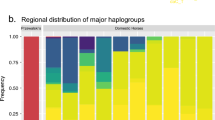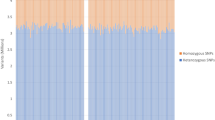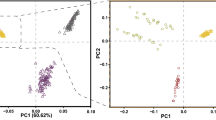Abstract
Specific formulations are derived for the correlation between the heterozygosity of a randomly mating parent and its offspring for a diallelic locus, and for the correlation when multiple loci are considered. The expected correlation is maximal, approaching r=0.50, when allelic frequencies are highly asymmetric, and it is zero when the allelic frequencies are equal to 0.50. Parent-offspring correlations, up to a maximum of 0.50 for diallelic loci, indicate that levels of heterozygosity can respond to selection. Multilocus allozyme data from limber pine, Pinus flexilis, and from horses of standardbred and thoroughbred breeds are used to demonstrate correlations between a parent and its offspring. The Spearman rank correlation between the heterozygosity of a limber pine and the mean heterozygosity of her offspring is r=0.45. Correlations in the horses range from r=0.16 to 0.32.
Similar content being viewed by others
Article PDF
References
Allendorf, F W, and Leary, R F. 1986. Heterozygosity and fitness in natural populations of animals. In: Soule, M. E. (ed.) Conservation Biology: The Science of Scarcity and Diversity, Sinauer Associates, Sunderland, MA, pp. 57–76.
Beardmore, J A. 1983. Extinction, survival, and genetic variation. In: Schonewald-Cox, C. M., Chambers, S. M., MacBryde, B. and Thomas, W. L. (eds), Genetics and Conservation: A Reference for Managing Wild Animal and Plant Populations, Benjamin/Cummings Publishing Co., Menlo Park, CA, pp. 125–151.
Bush, R M, Smouse, P E, and Ledig, F T. 1987. The fitness consequences of multiple-locus heterozygosity: the relationship between heterozygosity and growth rate in pitch pine (Pinus rigida Mill). Evolutional, 787–798.
Cothran, E G, Chesser, R, Smith, M H, and Johns, P E. 1983. Influences of genetic variability and maternal factors on fetal growth in white-tailed deer. Evolution, 37, 282–291.
Danzmann, R G, Ferguson, M M, and Allendorf, F W. 1987. Heterozygosity and oxygen-consumption rates as predictors of growth and developmental rate in rainbow trout. Physiol Zool, 60, 211–220.
Diehl, W J. 1988. Genetics of carbohydrate metabolism and growth in Eisenia foetida (Oligochaeta: Lumbricidae). Heredity, 61, 379–387.
Falconer, D S. 1989. Introduction to Quantitative Genetics. 3rd edn, John Wiley and Sons, New York.
Ferguson, M M, and Drahushchak, L R. 1990. Disease resistance and enzyme heterozygosity in rainbow trout. Heredity, 64, 413–417.
Gajardo, G M, and Beardmore, J A. 1989. Ability to switch reproductive mode in Artemia is related to maternal heterozygosity. Marine Ecol Prog Ser, 55, 191–195.
Garton, D W. 1984. Relationship between multiple locus heterozygosity and physiological energetics of growth in the estuarine gastropod Thais haemastoma. Physiol Zool, 57, 530–543.
Ginzburg, L R. 1979. Why are heterozygotes often superior in fitness? Theoret Popul Biol, 15, 264–267.
Ginzburg, L R. 1983. Theory of Natural Selection and Population Growth. Benjamin/Cummings, Menlo Park, CA.
Hawkins, A J S, Bayne, B L, and Day, A J. 1986. Protein turnover, physiological energetics and heterozygosity in the blue mussel, Mytilus edulis: the basis of variable age-specific growth. Proc R Soc Lond B, 229, 161–176.
Hawkins, A J S, Bayne, B L, Day, A J, Rusin, J, and Worrall, C M. 1989. Genotype-dependent interrelations between energy metabolism, protein metabolism and fitness. In: Ryland, J. S. and Tyler, P. A. (eds), Reproduction, Genetics and Distributions of Marine Organisms Olsen and Olsen, Fredensborg, Denmark, pp. 283–292.
Koehn, R K, Diehl, W J, and Scott, T M. 1988. The differential contribution by individual enzymes of glycolysis and protein catabolism to the relationship between heterozygosity and growth rate in the coot clam, Mulinia lateralis. Genetics, 118, 121–130.
Koehn, R K, and Shumway, S E. 1982. A genetic/physiological explanation for differential growth rate among individuals of the American oyster, Crassostrea virginica (Gmelin). Marine Biol Lett, 3, 35–42.
Ledig, F T. 1986. Heterozygosity, heterosis, and fitness in outbreeding plants. In: Soule, M. E. (ed.), Conservation Biology: The Science of Scarcity and Diversity, Sinauer Associates, Sunderland, MA, pp. 77–104.
Mitton, J B. 1989. Physiological and demographic variation associated with allozyme variation. In: Soltis, D. and Soltis, P. (eds) Isozymes in Plants, Dioscorides Press, Portland, OR, pp. 127–145.
Mitton, J B. 1993. Theory and data pertinent to the relationship between heterozygosity and fitness. In: Thornhill, N. (ed.) The Natural History of Inbreeding and Outbreeding, University of Chicago Press, Chicago, IL, pp. 17–41.
Mitton, J B, and Grant, M C. 1984. Associations among protein heterozygosity, growth rate, and developmental homeostasis. Ann Rev Ecol Syst, 15, 479–499.
Mitton, J B, and Jeffers, R M. 1989. The genetic consequences of mass selection for growth rate in Engelmann spruce. Silvae Genet, 38, 6–12.
Mitton, J B, and Pierce, B A. 1980. The distribution of individual heterozygosity in natural populations. Genetics, 95, 1043–1054.
Mopper, S, Mitton, J B, Whitham, T G, Cobb, N S, and Christensen, K M. 1991. Genetic differentiation and heterozygosity in pinyon pine associated with resistance to herbivory and environmental stress. Evolution, 45, 989–999.
Pecon Slattery, J, Vrijenhoek, R C, and Lutz, R A. 1991. Heterozygosity, growth, and survival of the hard clam, Mercenaria mercenaria, in seagrass vs sandflat habitats. Marine Biol, 111, 335–342.
Pierce, B A, and Mitton, J B. 1982. Allozyme heterozygosity and growth in the tiger salamander, Ambystoma tigrinum. J Hered, 73, 250–253.
Rodhouse, P G, McDonald, J H, Newell, R I E, and Koehn, R K. 1986. Gamete production, somatic growth and multiple locus heterozygosity in Mytilus edulis L. Marine Biol, 90, 209–214.
Schuster, W S F. 1989. Population structure and demography of an isolated stand of limber pine (Pinus flexilis James). Ph. D Thesis, University of Colorado, Boulder, CO.
Teska, W R, Smith, M H, and Novak, J M. 1990. Food quality, heterozygosity, and fitness correlated in Peromyscus polionotus. Evolution, 44, 1318–1325.
Turelli, M, and Ginzburg, L. 1983. Should individual fitness increase with heterozygosity? Genetics, 104, 191–209.
Zouros, E, and Foltz, D W. 1987. The use of allelic isozyme variation for the study of heterosis. In: Rattazzi, M. C., Scandalios, J. G. and Whitt, G. S. (eds), Isozymes: Current Topics in Biological and Medical Research, Vol. 13, Alan R. Liss, New York, pp. 1–59.
Zouros, E, Singh, S M, and Miles, H E. 1980. Growth rate in oysters: an overdominant phenotype and possible explanations. Evolution, 34, 856–867.
Author information
Authors and Affiliations
Rights and permissions
About this article
Cite this article
Mitton, J., Schuster, W., Cothran, E. et al. Correlation between the individual heterozygosity of parents and their offspring. Heredity 71, 59–63 (1993). https://doi.org/10.1038/hdy.1993.107
Received:
Issue date:
DOI: https://doi.org/10.1038/hdy.1993.107
Keywords
This article is cited by
-
High level of extra-pair paternity in the socially monogamous Marsh Tits (Poecile palustris)
Avian Research (2021)
-
Genetic mating system, population genetics and effective size of Saffron Finches breeding in southern South America
Genetica (2019)
-
Paternity success depends on male genetic characteristics in the terrestrial isopod Armadillidium vulgare
Behavioral Ecology and Sociobiology (2017)
-
Genetic variance components and heritability of multiallelic heterozygosity under inbreeding
Heredity (2016)
-
No facultative manipulation of offspring sex ratio in relation to parental genetic characteristics in a bird with sex-specific heterozygosity-fitness correlation
Behavioral Ecology and Sociobiology (2016)



